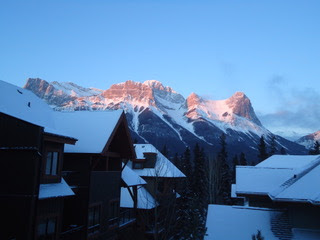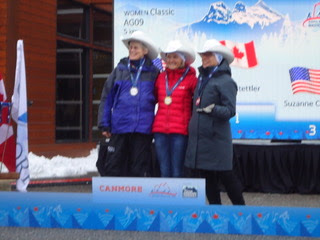Canmore World Masters_The Big Picture
Many thanks to Rob Corkran for this awesome report from last week's World Masters in Canmore and the photos!
***
Canmore is one of the more spectacular settings for any ski race. Situated several hundred feet above the valley floor on which the town is located, a row of castellated peaks looms directly above the sprawling stadiums. The stadium complex is subject to storm winds, but the trails are primarily in protected forest, with the exception of one area of meadow. Though much of the forest consists of trees of maybe 100 feet in height, few parts of the trail come without a view... either straight up at the peaks towering over you or straight ahead of you as the trails tend to be aligned in the same north-south direction as the peaks. There were three competition trails cobbled together from the myriad of trails in the provincial park, each overlapping in spots, ones of 5,10 and 15 kilometers all beautifully undulating. They were all on intermediate level trails. My wife, Suzanne Corkran, loved them.
Suzanne did have a substantial letdown regarding the courses. Our first day out skiing was the day before official training opened. They had lost snow and the lower parts of the 15k course were short on snow and quite icy. She was skiing on zeros but I had put on violet klister. We were to ski the 15k course and her zeros were not working. We changed skis and she zipped around the 15k, loving the course, while I assumed her struggles on the zeros. Only after rhapsodizing about the 15k course did she realize that as a newly minted M9 (70-74 years) she would be consigned to skiing the less interesting 5k three times! Men are 75 before they must accept that fact! Comments, ladies?
Despite the drawbacks for one group or another, this was a Masters World Cup not to be missed on account of its stunning beauty and marvelously groomed trails. Several minor snowfalls as well as some artificial snow brought the courses into optimal shape. On the 5k Suzanne found that she could stay in the track the entire time, sweeping around corners in a tuck often at speeds much higher than those at which she is comfortable. Despite these attractions, attendance was down to 700 some participants from the 1100 or so at the last one held at Beitostolen, Norway, in 2019.
Covid 19 certainly impacted these games beyond the number of skiers. Participants were more dispersed than usual and there was no central location where they could gather for meals. Most skiers stayed in units where they could prepare their own meals. However, Alberta had eliminated its masking requirements a few days prior to the opening. Whereas many people were masked in the stadium day lodge in the first few days, almost all were not by the end.
The competitors from the Seattle area were fewer than usual and included Kongsberger Ski Club members Rune Harkestad, Suzanne Corkran, Paul Kaald and Pat Kaald. Redmond skier Bert Pschunder, a regular at these events, was present. Longtime KSC member Kent Murdoch, now in the Methow, made the trip. Also at Canmore was Sam Flora, skiing in M11. Sam and his wife Berit were Kongsbergers 45 years ago. Berit and Suzanne had quite the rivalry in races then, but she was unable to attend Canmore. Their son Erik is one of the leading coaches in the US, running the APU program in Alaska.
Competitions available include in order a middle, short and long distance, either free or classic, plus a relay. Distances vary by age group. Competitors can ski three races of choice and put their name forward for a relay team. JD Downing, who is head of AXCL as well as the World Masters, draws up the US teams from the names proffered in consultation with the athletes.
KSC president Rune Harkestad, a perennial candidate for a medal, got off on the wrong foot. I doubt you have ever seen, or will see again, Rune crossing the start line struggling to get on his gloves while striding, not one skier from his wave to be seen in the the vast expanse of the start area, save himself. In an extraordinary effort, by the end of the first 15k lap Rune had passed almost the entire field and was slightly more than a minute behind the leader! He paid a price however, but held on to place third in the 30k classic in M6, 55-59 yrs. Rune’s nemesis was a Swiss skier, one Gian Joerger. Rune placed second to him in the subsequent races. In the long distance race, 45k for his age group, Rune made a valiant effort and was only a half minute behind Joerger at 15k, but fell back as the race progressed. Joerger is not only fast, but is also a metronome, clocking equally timed laps at just under 3 minutes per kilometer. In the brutally frozen relay with a delayed start, Rune was asked to ski a classic leg in M3, 40-44 years. Going second in classic technique, he provided 21 seconds of the 39-second margin of victory over Canada. All in all an excellent venture for Rune, despite the shaky start.
Bert Pschunder is a regular age group winner in local races, currently an M8, 65-69yrs. I did not see Bert during our stay, such was a result of the isolation imposed by Covid. Bert races freestyle. His best race appears to have been his long distance race, a 30k in which he finished 19th in a field of 29 in 1:47:45. But Bert stood out in that race. He managed a second lap faster than his first, the only one in the field to do so. In addition, only one other skier came closer to even lap times.
Kent Murdoch, an M7 (60-64), had a great run. He was second to his rival and friend Barry Makarewicz of Salt Lake City in both the medium and long distance freestyle races. With Barry skiing the short classic, Kent won the short freestyle. Barry scrambled and Kent anchored the M7 relay team, victorious against Canada, Finland and France.
My wife Suzanne, in her fourth World Masters and at 70 in her first year of M9, had her best yet results, winning her first medals, two bronze and one gold. Though the field was smaller than usual, two skiers were those whom my wife calls “super skiers”: Carolyn Tiernan of Bishop, California, and Silvia Stettler of Canada. They both regularly ski 18-minute classic 5ks. (Another such skier is M10 Trina Hosmer, who at 76 skied a 17:38 classic 5k! Trina, an Easterner, was a Kongsberger for a year or so before she was a member of the 1970 United States FIS World Championship team. A team mate was Alison Owen of the Wenatchee Racing Team. They were two of the three who were the first women in xc skiing to represent this country at the FIS Championships.) Another “super skier” is a longtime KSC member now resident in the Methow, Ginny Price. She was not at this event. [ed. note: she was at the Norwegian Birkebeiner, where she won the women's 70-74 age group!] Much of the remainder of the women’s M9 field was strong also, comprising among others all of the medalists in the distance race at Minneapolis in 2018, one of whom was a Norwegian who won a bronze in Beitostolen in 2019 where the field was larger and stacked with Norwegians!
Paul and Pat Kaald were last-minute entrants in M12 (85-89) and M11 (80-84). Paul wore his hat from the last Canmore Masters, 1998, I believe. Apart from the difficulties of entering Canada that all foreign entrants suffered, the Kaalds had their own unique problems. Paul ran over his glasses but Pat was the one disqualified for a wrong turn in the 10k, thus ceding bragging rights for medals to her husband. Many racers who previously vied for medals might be too proud to enter a major ski race during their declining years. Not Paul. He continues to enjoy the experience and is not the least bothered that his three medals were awarded for participation as much as time. He will point out with a wry smile that in the race where he received bronze, there were actually four people in the race! At their finishes Paul and Pat were warmly received by the announcer, who did not fail to note that they were the oldest entrants in their gender, 89 and 84. The Kaalds, when not training or racing on the trails, were often to be seen in the day lodge, coffee in hand, sharing battle stories, renewing ties with old friends and making new ones.
Despite the Covid trials, this World Masters was spectacularly successful. The weather cooperated with mostly clear skies, the exception being a very cold delayed relay start and a brief mini blizzard that coincided with the start of the short skate races, with horizontally driven snow directly in the faces of the starters. Even the medal awards were more interesting. They opened and closed with prayers, songs and dances offered by First Peoples. They were held outside in often bracing breezes, with peaks in the twilight providing a backdrop. Medalists were not only accorded a brief rendition, a few bars, of their national anthems (the winners, at least) but they were temporarily given a cowboy hat for their time on the podium. A constant refrain was a medalist walking off stage with one of the three hats in use!
There were also magnificent side trips. Suzanne and I went skiing on Lake Louse, about forty-five miles north of Canmore. I left my poles there and we wound up buying a new set of Rundle poles for Suzanne and replacing the handles on Suzanne’s poles for me! A key to the success of Suzanne’s decisive double poling in the 15k? Who knows.
So if you have never been to one of these things and your partner wants to give it a go, do not fail to accompany him/her. If the two of you wish to compete, it might be a little more complicated but so much the better. It will be fun in Seefeld, Austria, next year, and I bet the Kaalds are already thinking about it!








Comments
Post a Comment